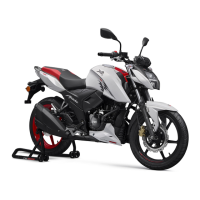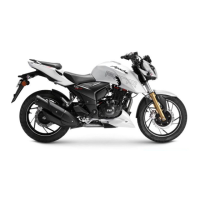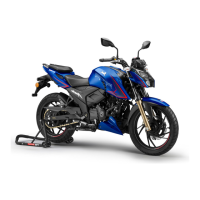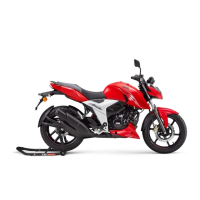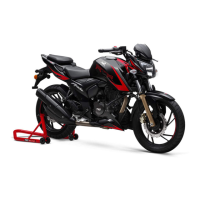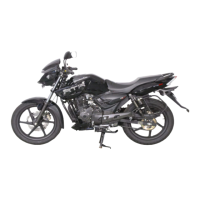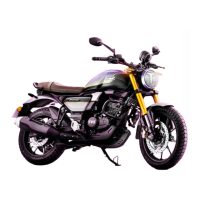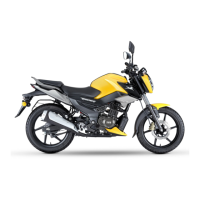Do you have a question about the TVS Apache RTR 160 BS-VI and is the answer not in the manual?
Provides contact information for TVS Motor Company's regional offices across India.
Discusses the TVS Apache brand's history, performance, and rider community.
Details riding apparel and urban wear for riders, emphasizing safety and style.
Showcases key achievements and milestones in TVS Racing's history.
Provides notes on manual content, specifications, and potential updates.
Explains the meaning of warning, caution, and note symbols used in the manual.
Provides guidelines for the initial period of motorcycle operation for optimal performance.
Highlights the significance of the first free service for engine longevity.
Explains how the ABS system works, how it detects wheel locking, and its benefits.
Details the ABS warning lamp behavior and provides essential precautions for ABS use.
Advises on getting familiar with the bike and wearing appropriate riding apparel for safety.
Guides on proper posture, safe cornering, and effective braking techniques.
Explains the vehicle's crankcase and evaporative emission control systems for compliance.
Explains the importance and location of frame and engine serial numbers for identification.
Identifies and describes controls and components on the left handlebar.
Illustrates and lists major components located on the left side of the vehicle.
Illustrates and lists major components located on the right side of the vehicle.
Identifies front turn signals, headlamp, and position lamps.
Identifies rear turn signals, tail lamp, and number plate lamp.
Explains the 'OFF', 'ON', and 'LOCK' positions of the ignition cum steering lock.
Describes the function and behavior of the Malfunction Indicator Lamp (MIL).
Details low fuel, service reminder, ABS, high beam, and neutral indicators.
Explains odometer reading, trip meters A & B, and their display.
Details the high speed and shortest time indicator functions.
Details how to reset ODO and trip meters A and B using mode and set switches.
Provides a step-by-step guide for setting the digital clock time and format.
Explains the operation of horn, turn signal, and pass-by switches on the left handlebar.
Details how to control the headlamp beam (high/low) using the switch.
Describes the function of the electric starter and engine cut-off switches.
Explains the operation of the front brake lever and throttle grip.
Provides instructions for opening and securely closing the flush-type fuel tank cap.
Explains the vehicle's Evaporative Emission Control System (EVAP).
Offers warnings and cautions regarding safe refueling practices.
Describes how to operate the 5-speed gear shift lever for smooth transmission.
Explains the air duct's role in guiding air for engine cooling and performance.
Describes the dual catalytic converter for emission control and its high temperature.
Details how to control vehicle speed using the rear brake pedal.
Discusses factors affecting braking performance and safety precautions.
Explains the correct procedure for using the center and side stands for parking.
Details how to open and reassemble the lockable cover frame on the right side.
Describes the location and contents of the vehicle's tool kit and first aid kit.
Lists essential items and checks to perform before starting the vehicle.
Outlines necessary conditions to check before attempting to start the engine.
Guides on engaging first gear and smoothly moving the vehicle forward.
Provides advice on managing power and using the engine as a brake on inclines.
Details steps for stopping the vehicle and parking it safely on a firm surface.
Specifies the type of petrol to use and cautions about ethanol mixtures.
Offers advice on regular checks and spark plug maintenance for better fuel economy.
Explains air cleaner element function and clutch operation/adjustment.
Covers engine oil level checks and actions for suspected fuel leaks.
Discusses the impact of low tyre pressure on vehicle handling and economy.
Emphasizes regular tyre pressure checks and chain slackness for fuel efficiency.
Advises against fast starts, unnecessary idling, and frequent braking for better mileage.
Stresses the necessity of adhering to the maintenance schedule for vehicle reliability.
Lists items and services to be performed during free service intervals.
Outlines maintenance tasks for after the free service period.
Details checks for steering, front/rear suspension, and fastener tightness.
Covers drive chain inspection, bulb checks, and battery voltage monitoring.
Outlines checks for brake effectiveness, fluid, and wheel components.
Details checks for brake shoe/pad wear, brake fluid, and toner ring integrity.
Covers tyre pressure checks and lubrication of stands and pivots.
Advises on checking the intactness of the evaporative emission control system hoses and canister.
Guides on checking the fuel tank assembly for leaks or abnormal noises.
Lists recommended engine oil, fork oil, and brake fluid specifications.
Specifies recommended grease and chain lubricant for maintenance.
Details how to check battery voltage and charge it using recommended chargers.
Advises on applying petroleum jelly to terminals to prevent corrosion.
Explains how to access and replace fuses located under the seat and cover frame.
Guides on cleaning, inspecting, and replacing the spark plug for optimal ignition.
Provides a step-by-step guide to check the engine cum transmission oil level accurately.
Explains how to measure the clutch lever free play for optimal clutch plate life.
Details the procedure for adjusting the clutch cable to achieve correct free play.
Explains how to adjust the rear shock absorber spring load for different conditions.
Guides on checking the front brake master cylinder fluid level through the view piece glass.
Details how to check the brake fluid level in the rear brake reservoir.
Explains how to visually check brake pads for wear and when to replace them.
Guides on measuring the free play of the rear brake pedal before engagement.
Explains how to index the brake lever to extend shoe life based on wear indicator.
Advises on regular tyre pressure checks and their impact on stability and economy.
Explains how to check tyre tread wear using the indicator and when to replace tyres.
Guides on ensuring correct tyre rotation direction during reassembly.
Recommends visiting specialized shops for tubeless tyre puncture repair.
Details procedures for cleaning, lubricating, and adjusting drive chain slackness.
Provides a step-by-step guide for safely removing the front wheel.
Offers precautions for correct reassembly of the front wheel and its components.
Details the procedure for removing the rear wheel on disc brake models.
Details the procedure for removing the rear wheel on drum brake models.
Provides a comprehensive guide for storing the motorcycle for extended periods.
Lists essential checks and procedures before using the vehicle after storage.
Explains the warranty period and coverage for manufacturing defects.
Lists conditions under which the warranty does not apply.
Outlines the steps a customer must follow to make a warranty claim.
Provides contact numbers for battery-related inquiries.
Lists parts excluded from warranty due to normal maintenance or wear and tear.
Details exclusions for electrical parts, service maintenance items, and proprietary components.
Covers exclusions related to damage, unauthorized alterations, specific usage, and transfers.
Explains the scheme of free and pay services available during the warranty period.
Emphasizes that scheduled servicing is crucial for maintaining warranty and performance.
Introduces the express service offering for quick bike servicing.
Highlights the convenience of servicing the bike at the customer's doorstep.
Describes the service offering for picking up and dropping the bike for servicing.
Lists key engine parameters like bore, stroke, power, torque, and transmission details.
Details the gear ratios and primary/final reduction values for the transmission.
Provides overall dimensions, wheelbase, weight, and payload capacity.
Lists tyre sizes, types, and recommended pressures for optimal performance.
Describes the front and rear brake systems, including disc and drum types.
Details ignition system, generator, lighting, indicators, fuses, and battery specs.
Specifies fuel tank capacity, engine oil, fork oil, and brake fluid volumes.
Explains the legal requirement for vehicle insurance and lists preferred insurers.
Provides contact information for TVS Motor Company's regional offices across India.
Discusses the TVS Apache brand's history, performance, and rider community.
Details riding apparel and urban wear for riders, emphasizing safety and style.
Showcases key achievements and milestones in TVS Racing's history.
Provides notes on manual content, specifications, and potential updates.
Explains the meaning of warning, caution, and note symbols used in the manual.
Provides guidelines for the initial period of motorcycle operation for optimal performance.
Highlights the significance of the first free service for engine longevity.
Explains how the ABS system works, how it detects wheel locking, and its benefits.
Details the ABS warning lamp behavior and provides essential precautions for ABS use.
Advises on getting familiar with the bike and wearing appropriate riding apparel for safety.
Guides on proper posture, safe cornering, and effective braking techniques.
Explains the vehicle's crankcase and evaporative emission control systems for compliance.
Explains the importance and location of frame and engine serial numbers for identification.
Identifies and describes controls and components on the left handlebar.
Illustrates and lists major components located on the left side of the vehicle.
Illustrates and lists major components located on the right side of the vehicle.
Identifies front turn signals, headlamp, and position lamps.
Identifies rear turn signals, tail lamp, and number plate lamp.
Explains the 'OFF', 'ON', and 'LOCK' positions of the ignition cum steering lock.
Describes the function and behavior of the Malfunction Indicator Lamp (MIL).
Details low fuel, service reminder, ABS, high beam, and neutral indicators.
Explains odometer reading, trip meters A & B, and their display.
Details the high speed and shortest time indicator functions.
Details how to reset ODO and trip meters A and B using mode and set switches.
Provides a step-by-step guide for setting the digital clock time and format.
Explains the operation of horn, turn signal, and pass-by switches on the left handlebar.
Details how to control the headlamp beam (high/low) using the switch.
Describes the function of the electric starter and engine cut-off switches.
Explains the operation of the front brake lever and throttle grip.
Provides instructions for opening and securely closing the flush-type fuel tank cap.
Explains the vehicle's Evaporative Emission Control System (EVAP).
Offers warnings and cautions regarding safe refueling practices.
Describes how to operate the 5-speed gear shift lever for smooth transmission.
Explains the air duct's role in guiding air for engine cooling and performance.
Describes the dual catalytic converter for emission control and its high temperature.
Details how to control vehicle speed using the rear brake pedal.
Discusses factors affecting braking performance and safety precautions.
Explains the correct procedure for using the center and side stands for parking.
Details how to open and reassemble the lockable cover frame on the right side.
Describes the location and contents of the vehicle's tool kit and first aid kit.
Lists essential items and checks to perform before starting the vehicle.
Outlines necessary conditions to check before attempting to start the engine.
Guides on engaging first gear and smoothly moving the vehicle forward.
Provides advice on managing power and using the engine as a brake on inclines.
Details steps for stopping the vehicle and parking it safely on a firm surface.
Specifies the type of petrol to use and cautions about ethanol mixtures.
Offers advice on regular checks and spark plug maintenance for better fuel economy.
Explains air cleaner element function and clutch operation/adjustment.
Covers engine oil level checks and actions for suspected fuel leaks.
Discusses the impact of low tyre pressure on vehicle handling and economy.
Emphasizes regular tyre pressure checks and chain slackness for fuel efficiency.
Advises against fast starts, unnecessary idling, and frequent braking for better mileage.
Stresses the necessity of adhering to the maintenance schedule for vehicle reliability.
Lists items and services to be performed during free service intervals.
Outlines maintenance tasks for after the free service period.
Details checks for steering, front/rear suspension, and fastener tightness.
Covers drive chain inspection, bulb checks, and battery voltage monitoring.
Outlines checks for brake effectiveness, fluid, and wheel components.
Details checks for brake shoe/pad wear, brake fluid, and toner ring integrity.
Covers tyre pressure checks and lubrication of stands and pivots.
Advises on checking the intactness of the evaporative emission control system hoses and canister.
Guides on checking the fuel tank assembly for leaks or abnormal noises.
Lists recommended engine oil, fork oil, and brake fluid specifications.
Specifies recommended grease and chain lubricant for maintenance.
Details how to check battery voltage and charge it using recommended chargers.
Advises on applying petroleum jelly to terminals to prevent corrosion.
Explains how to access and replace fuses located under the seat and cover frame.
Guides on cleaning, inspecting, and replacing the spark plug for optimal ignition.
Provides a step-by-step guide to check the engine cum transmission oil level accurately.
Explains how to measure the clutch lever free play for optimal clutch plate life.
Details the procedure for adjusting the clutch cable to achieve correct free play.
Explains how to adjust the rear shock absorber spring load for different conditions.
Guides on checking the front brake master cylinder fluid level through the view piece glass.
Details how to check the brake fluid level in the rear brake reservoir.
Explains how to visually check brake pads for wear and when to replace them.
Guides on measuring the free play of the rear brake pedal before engagement.
Explains how to index the brake lever to extend shoe life based on wear indicator.
Advises on regular tyre pressure checks and their impact on stability and economy.
Explains how to check tyre tread wear using the indicator and when to replace tyres.
Guides on ensuring correct tyre rotation direction during reassembly.
Recommends visiting specialized shops for tubeless tyre puncture repair.
Details procedures for cleaning, lubricating, and adjusting drive chain slackness.
Provides a step-by-step guide for safely removing the front wheel.
Offers precautions for correct reassembly of the front wheel and its components.
Details the procedure for removing the rear wheel on disc brake models.
Details the procedure for removing the rear wheel on drum brake models.
Provides a comprehensive guide for storing the motorcycle for extended periods.
Lists essential checks and procedures before using the vehicle after storage.
Explains the warranty period and coverage for manufacturing defects.
Lists conditions under which the warranty does not apply.
Outlines the steps a customer must follow to make a warranty claim.
Provides contact numbers for battery-related inquiries.
Lists parts excluded from warranty due to normal maintenance or wear and tear.
Details exclusions for electrical parts, service maintenance items, and proprietary components.
Covers exclusions related to damage, unauthorized alterations, specific usage, and transfers.
Explains the scheme of free and pay services available during the warranty period.
Emphasizes that scheduled servicing is crucial for maintaining warranty and performance.
Introduces the express service offering for quick bike servicing.
Highlights the convenience of servicing the bike at the customer's doorstep.
Describes the service offering for picking up and dropping the bike for servicing.
Lists key engine parameters like bore, stroke, power, torque, and transmission details.
Details the gear ratios and primary/final reduction values for the transmission.
Provides overall dimensions, wheelbase, weight, and payload capacity.
Lists tyre sizes, types, and recommended pressures for optimal performance.
Describes the front and rear brake systems, including disc and drum types.
Details ignition system, generator, lighting, indicators, fuses, and battery specs.
Specifies fuel tank capacity, engine oil, fork oil, and brake fluid volumes.
Explains the legal requirement for vehicle insurance and lists preferred insurers.
| Engine Type | Single Cylinder, 4 Stroke, Air Cooled |
|---|---|
| Displacement | 159.7 cc |
| Fuel System | Fuel Injection |
| Front Suspension | Telescopic Forks |
| Rear Suspension | Monoshock |
| Fuel Tank Capacity | 12 L |
| Seat Height | 800 mm |
| Tyre Size (Front) | 90/90-17 |
| Compression Ratio | 9.8:1 |
| Frame Type | Double Cradle |
| Front Tyre | 90/90-17 |
| Ground Clearance | 180 mm |
| Tail Lamp | LED |
| Speedometer | Digital |
| Odometer | Digital |
| Tripmeter | Digital |
| Tachometer | Digital |
| ABS | Single Channel ABS |
| Transmission | 5 Speed |
| Front Brake | Disc Brake |
| Rear Brake | Drum Brake |
| Tyre Size (Rear) | 110/80 - 17 |
| Ignition | Digital |
| Starting | Electric Start |
| Clutch | Wet, Multi-Plate |
| Rear Tyre | 110/80 - 17 |
| Headlamp | LED |

